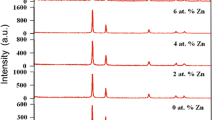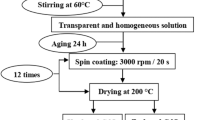Abstract
The investigation of semiconductor films of undoped ZnO and doped with two weight percentages of Cadmium (0.5 and 3) were grown on glass and silicon substrates under the same conditions using the dip-coating method. The X-ray diffraction patterns showed the growth of the wurtzite ZnO phase in a hexagonal crystal structure. Also, the effect of both cadmium concentration and substrate type is very clear, while the films those grown on glass substrate showed a crystallization with a highly c-axis preferred (002) orientation, those grown on a silicon substrate showed regular growth in all directions of the zinc oxide phase. The average crystallites size is of the nano-metric scale, more precise about 27 nm, supported with images taken with Environmental Scanning Electron Microscopy, furthermore from the latter technic (ESEM), we noticed a presence of three morphological types on the surface, were originated according to the substrate type and quantity of Cd-doping. The Rutherford Backscattering Spectrometry simulation spectra and the Auger Electron Spectroscopy by the relation with the stripping time emphasize the subsistence of starting (Zn) and doping (Cd) elements on the final specimens and in proportional quantities, to deduce that the undoped ZnO specimen thin film is the thickest. All the obtained films have an optical transmission of about 80% level within the visible range and a severe absorption beginning about 370 nm corresponding to the fundamental absorption limit, where the optical band gap energy decreased from 3.21 eV to 3.16 eV for the undoped ZnO and doped with 3 wt.% Cd respectively. The room-temperature luminescence emission spectra of all specimens were excited at the same conditions under 250 nm Xenon lamp excitation, where showed ultraviolet and visible emissions for all the films grown on a glass and silicon substrate, while an opposite reaction was recorded in the intensity of the spectra as the percentage of Cd increased.

















Similar content being viewed by others
References
B. Rahal, B. Boudine, N. Souami, M. Siad, M. Sebais, O. Halimi, L. Guerbous, Behavior study of the nanostructured Zn1-xCdxO (0 ≤ x ≤ 0.1) semiconductor thin films deposited onto silicon substrate by dip-coating method. J. Silicon 12, 2967–2976 (2020). https://doi.org/10.1007/s12633-020-00388-3
G. Li, X. Zhu, X. Tang, W. Song, Z. Yang, J. Dai, Y. Sun, X. Pan, S. Dai, Doping and annealing effects on ZnO: Cd thin films by sol–gel method. J. Alloy. Compd. 509, 4816–4823 (2011). https://doi.org/10.1016/j.jallcom.2011.01.176
B. Rahal, B. Boudine, Y. Larbah, L. Guerbous, M. Sebais, O. Halimi, M. Siad, Sol-gel synthesis and nanostructured semiconductor analysis of undoped and Cd-doped ZnO thin films. J. Optik- Int. J. Light Electron Optics 169, 303–313 (2018). https://doi.org/10.1016/j.ijleo.2018.05.070
Z.L. Wang, ZnO nanowire and nanobelt platform for nanotechnology. Mater. Sci. Eng. R. Rep. 64, 33–71 (2009). https://doi.org/10.1016/j.mser.2009.02.001
B. Rahal, B. Boudine, A.R. Khantoul, M. Sebais, O. Halimi, Colloidal synthesis of nanostructured pure ZnO and Cd doped ZnO thin films and their characterization. J. Optik- Int. J. Light Electron Optics 127, 6943–6951 (2016). https://doi.org/10.1016/j.ijleo.2016.05.006
O. Lupan, L. Chow, G. Chai, A. Schulte, S. Park, O. Lopatiuk-Tirpak, L. Chernyak, H. Heinrich, Biopolymer-assisted self-assembly of ZnO nano-architectures from nanorods. Superlattices Microstruct. 43, 292–302 (2008). https://doi.org/10.1016/j.spmi.2007.12.003
U. Özgür, D. Hofstetter, H. Morkoç, ZnO Devices and Applications: a review of current status and future prospects. Proc. IEEE 98, 1255–1268 (2010). https://doi.org/10.1109/JPROC.2010.2044550
J.L. Gomez, O. Tigli, Zinc oxide nanostructures: from growth to application. J. Mater. Sci. 48, 612–624 (2013). https://doi.org/10.1007/s10853-012-6938-5
Z.L. Wang, Piezotronic and Piezophototronic Effects. J. Phys. Chem. Lett. 1, 1388–1393 (2010). https://doi.org/10.1021/jz100330j
B. Gharbi, A. Taabouche, M. Brella, R. Gheriani, Y. Bouachiba, A. Bouabellou, F. Hanini, S. Barouk, H. Serrar, B. Rahal, Spray pyrolysis synthesized and ZnO-NiO nanostructured thin films analysis with their nanocomposites for waveguiding applications. Semiconductors 55, 37–43 (2020). https://doi.org/10.1134/S1063782621010085
A. Herzi, M. Sebais, B. Boudine, O. Halimi, B. Rahal, L. Guerbous, Fabrication and characterization of highly textured thin films of undoped and Ag-Doped ZnO. Acta Physica Polonica A 135, 526–531 (2019). https://doi.org/10.12693/APhysPolA.135.526
J.H. Lee, B.O. Park, Transparent conducting ZnO: Al, and Sn thin films deposited by the sol gel method. Thin Solid Films 426, 94–99 (2003). https://doi.org/10.1016/S0040-6090(03)00014-2
R. Viter, K. Kunene, P. Genys, D. Jevdokimovs, D. Erts, A. Sutka, K. Bisetty, A. Viksna, A. Ramanaviciene, A. Ramanavicius, Photoelectrochemical bisphenol S sensor based on ZnO-Nanoroads modified by molecularly imprinted Polypyrrole. Macromol. Chem. Phys. 221, 1900232 (2020). https://doi.org/10.1002/macp.201900232
A. Tereshchenko, G.R. Yazdi, I. Konup, V. Smyntyna, V. Khranovskyy, R. Yakimova, A. Ramanavicius, Application of ZnO Nanorods based whispering gallery mode resonator in optical immunosensors. Colloids Surf. B 191, e110999 (2020). https://doi.org/10.1016/j.colsurfb.2020.110999
I. Plikusiene, V. Maciulis, O. Graniel, M. Bechelany, S. Balevicius, V. Vertelis, Z. Balevicius, A. Popov, A. Ramanavicius, A. Ramanaviciene, Total internal reflection ellipsometry for kinetics-based assessment of bovine serum albumin immobilization on ZnO nanowires. J. Mater. Chem. C 9, 1345–1352 (2021). https://doi.org/10.1039/D0TC05193D
C. Karunakaran, A. Vijayabalan, G. Manikandan, Photocatalytic and bactericidal activities of hydrothermally synthesized nanocrystalline Cd-doped ZnO. Superlattices Microstruct. 51, 443–453 (2012). https://doi.org/10.1016/j.spmi.2012.01.008
X. Tang, H. Lu, Q. Zhang, J. Zhao, Y. Lin, Study on interactions between Cadmium and defects in Cd-doped ZnO by first-principle calculations. Solid State Sci. 13, 384–387 (2011). https://doi.org/10.1016/j.solidstatesciences.2010.11.040
M. Mayer, SIMNRA, a Simulation Program for the Analysis of NRA, RBS and ERDA 1999 Proceedings of the 15th International Conference on the Application of Ac-celerators in Research and Industry, J. L. Duggan and I.L. Morgan (eds.) American Institute of Physics Conference Proceedings 475 541 Doi: https://doi.org/10.1063/1.59188
A.R. Khantoul, M. Sebais, B. Rahal, B. boudine, O. halimi, Structural and optical properties of zno and co Doped ZnO thin films prepared by Sol-Gel. Acta Physica Polonica A 133, 114–117 (2018). https://doi.org/10.12693/APhysPolA.133.11
H. Benelmadjat, N. Touka, B. Harieche, B. Boudine, O. Halimi, M. Sebais, Study of structural and optical properties of Sb doped ZnO thin films deposited by spin coating method. Opt. Mater. 32, 764–767 (2010). https://doi.org/10.1016/j.optmat.2010.02.011
H. Benelmadjat, S. Boudjaadar, B. Boudine, A. Chelouche, O. Halimi, A. Boudrioua 2011 Improvement of structural and optical properties of ZnO thin films by thermal annealing, J. Optoelectron. Adv. Mater. 13 122–125. http://joam.inoe.ro
A.D. Acharya, S. Moghe, R. Panda, S.B. Shrivastava, M. Gangrade, T. Shripathi, D.M. Phase, V. Ganesan, Effect of Cd dopant on electrical and optical properties of ZnO thin films prepared by spray pyrolysis route. Thin Solid Films 525, 49–55 (2012). https://doi.org/10.1016/j.tsf.2012.10.100
H. Sutanto, S. Durri, S. Wibowo, H. Hadiyanto, E. Hidayanto, Rootlike Morphology of ZnO: Al thin film deposited on amorphous glass substrate by Sol-Gel Method. Phys. Res. Int. 2016, 4749587–4749597 (2016). https://doi.org/10.1155/2016/4749587
A. Taabouche, A. Bouabellou, F. Kermiche, F. Hanini, C. Sedrati, Y. Bouachiba, C. Benazzouz, Preparation and characterization of Al-doped ZnO piezoelectric thin films grown by pulsed laser deposition. Ceram. Int. 42, 6701–6706 (2016). https://doi.org/10.1016/j.ceramint.2016.01.033
M.S.E. Hamroun, C. Benazzouz, Thermally induced interfacial reactions in Ti/Pd/Si and Ti/Pd/Si (As) ternary systems. Appl. Phys. A 118, 1033–1037 (2014). https://doi.org/10.1007/s00339-014-8863-8
Y. Larbah, M. Adnane, B. Rahal, Growth and characterization of ZnO and Al-Doped ZnO thin films by a homemade spray pyrolysis. Semiconductors 54, 1439–1444 (2020). https://doi.org/10.1134/S1063782620110184
R. Yousefi, B. Kamaluddina, M. Ghoranneviss, F. Hajakbari, Auger and photo-luminescence analysis of ZnO nanowires grown on AlN thin film. Appl. Surf. Sci. 255, 6985–6988 (2009). https://doi.org/10.1016/j.apsusc.2009.03.025
L.C. Chao, S.H. Yang, Growth and Auger electron spectroscopy characterization of donut-shaped ZnO nanostructures. Appl. Surf. Sci. 253, 7162–7165 (2007). https://doi.org/10.1016/j.apsusc.2007.02.184
P.W. Palmberg, Optimization of Auger electron spectroscopy in LEED systems. Appl. Phys. Lett. 13, 183–185 (1968). https://doi.org/10.1063/1.1652562
Y. Larbah, M. Adnane, A. Djelloul, M. Melouki, Influence of Growth temperature on structure and optical properties of tin oxide films by spray pyrolysis method. J. Nano-Electron. Phys. 7, 30131–30134 (2015)
L.E. Davis, N.C. MacDonald, P.W. Palmberg, G.E. Riach, R.E. Weber, Handbook of Auger Electron Spectroscopy (Physical Electronics Eden Prairie, Minnesota, 1978).
Y. Larbah, B. Rahal, M. Adnane, The effect of fluorine doping on the properties of SnO2 thin films deposited using spray pyrolysis method. J. Optoelectron. Adv. Mater. 22, 518–522 (2020)
A.M. Mansour, M. Nasr, H.A. Saleh, G.M. Mahmoud, Physical characterization of 5′,5′′-dibromo-o-cresolsulfophthalein (BCP) spin-coated thin films and BCP/p-Si based diode. Appl. Phys. A Mater. Sci. Process. 125, 1–11 (2019). https://doi.org/10.1007/s00339-019-2920-2
D.M. Carballeda-Galicia, R. Castanedo-Pérez, O. Jiménez-Sandoval, S. Jiménez Sandoval, G. Tores-Dalgado, C.L. Zũñiga-Romero, High transmittance CdO thin films obtained by the sol-gel method. Thin Solid Films 371, 105–108 (2000). https://doi.org/10.1016/S0040-6090(00)00987-1
A.M. El Nahrawy, A.M. Mansour, A.B. Abou Hammad, R.S. Ibrahim, A.M. Abouelnaga, M.S. Abdel-Aziz, Optical, functional impact and antimicrobial of Chitosan/Phosphosilicate/Al2O3 Nanosheets. J. Inorg. Organomet. Polym. Mater. 30, 3084–3094 (2020). https://doi.org/10.1007/s10904-020-01469-x
A.M. El Nahrawy, A.B. Abou Hammad, A.M. bakr, Th.I. Shaheen, A.M. Mansour, Sol–gel synthesis and physical characterization of high impact polystyrene nanocomposites based on Fe2O3 doped with ZnO. Appl. Phys. A: Mater. Sci. Process. 126, e654 (2020). https://doi.org/10.1007/s00339-020-03822-w
Ü. Özgür, Y.I. Alivov, C. Liu, A. Teke, M.A. Reshchikov, S. Dogan, V. Avrutin, S.J. Cho, H. Morkoç, A comprehensive review of ZnO materials and devices. J. Appl. Phys. 98, 0413011–041301103 (2005). https://doi.org/10.1063/1.1992666
G.Y. Naser, W.N. Raja, A.S. Faris, Z.J. Rahem, M.A. Salih, A.H. Ahmed, Some optical properties of CdO thin films. Energy Procedia 36, 42–49 (2013). https://doi.org/10.1016/j.egypro.2013.07.006
H.S. Kang, S.H. Lim, J.W. Kim, H.W. Chang, G.H. Kim, J.H. Kim, S.Y. Lee, Y. Li, J.S. Lee, J.K. Lee, M.A. Nastasi, S.A. Crooker, Q.X. Jia, Exciton localization and Stokes’ shift in Zn1−xCdxO thin films depending on chemical composition. J. Cryst. Growth 287, 70–73 (2006). https://doi.org/10.1016/j.jcrysgro.2005.10.045
J.H. Lee, C.Y. Chou, Z. Bi, C.F. Tsai, H. Wang, Growth-controlled surface roughness in Al-doped ZnO as transparent conducting oxide. Nanotechnology 20, 3957041–3957047 (2009). https://doi.org/10.1088/0957-4484/20/39/395704
G. Luka, T.A. Krajewski, B.S. Witkowski, G. Wisz, I.S. Virt, E. Guziewicz, M. Godlewski, Aluminum-doped zinc oxide films grown by atomic layer deposition for transparent electrode applications. J. Mater. Sci.: Mater. Electron. 22, 1810–1815 (2011). https://doi.org/10.1007/s10854-011-0367-0
F.M. Chang, S. Brahma, J.H. Huang, Z.Z. Wu, K.Y. Lu, Strong correlation between optical properties and mechanism in deficiency of normalized self-assembly ZnO nanorods. Sci. Rep. 9, 905 (2019). https://doi.org/10.1038/s41598-018-37601-8
A. Boumaiza, B. Boudine, M. Sebais, Fabrication and characterization of pure and Pb-doped ZnO thin films prepared by Sol-Gel and Dip-coeting method. J. Inorg. Organomet. Polym Mater. (2021). https://doi.org/10.1007/s10904-021-01990-7
W.H. Lan, Y.L. Li, Y.C. Chung, Y.C. Chou, K.F. Huang, L.C. Chen, Effects of post anneal for the INZO films prepared by ultrasonic spray pyrolysis. Adv. Nano Res. 2, 179–186 (2014). https://doi.org/10.12989/anr.2014.2.4.179
N. Rouabah, B. Boudine, R. Nazir, M. Zaabat, M. Sebais, O. Halimi, M.T. Soltani, A. Chala, Structural, optical and photocatalytic properties of PVC/CdS nanocomposites prepared by soft chemistry method. J. Inorg. Organomet. Polym Mater. 31, 1102–1110 (2021). https://doi.org/10.1007/s10904-020-01752-x
M. Turemis, D. Zappi, M.T. Giardi, G. Basile, A. Ramanaviciene, A. Kapralovs, A. Ramanavicius, R. Viter, ZnO/polyaniline composite based photoluminescence sensor for the determination of acetic acid vapor. Talanta 211, e120658 (2020). https://doi.org/10.1016/j.talanta.2019.120658
R. Viter, M. Savchuk, N. Starodub, Z. Balevicius, S. Tumenas, A. Ramanaviciene, D. Jevdokimovs, D. Erts, I. Iatsunskyi, A. Ramanavicius, Photoluminescence immunosensor based on bovine leukemia virus proteinsimmobilized on the ZnO nanorods. Sens. Actuators, B Chem. 285, 601–606 (2019). https://doi.org/10.1016/j.snb.2019.01.054
I. Ameur, B. Boudine, M. Laidoudi, M. Khennoucha, V. Brien, D. Horwat, M. Sebais, O. Halimi, Influence of magnesium doping on microstructure, optical and photocatalytic activity of zinc oxide thin films synthesis by sol–gel route. Appl. Phys. A 127, 331 (2021). https://doi.org/10.1007/s00339-021-04486-w
Acknowledgements
We want to thank Mrs.: M. Laidoudi, A. Taabouche, C. Sedrati, M. Sebais, O. Halimi, L. Guerbous, M. Belamri, C. Benazzouz, A. Hammoudi and A. Mouatsi for their help and the morale support.
Author information
Authors and Affiliations
Corresponding author
Additional information
Publisher's Note
Springer Nature remains neutral with regard to jurisdictional claims in published maps and institutional affiliations.
Rights and permissions
About this article
Cite this article
Rahal, B., Boudine, B., Larbah, Y. et al. Influence of Low Cd-Doping Concentration (0.5 and 3 wt.%) and Different Substrate Types (Glass and Silicon) on the Properties of Dip-Coated Nanostructured ZnO Semiconductors Thin Films. J Inorg Organomet Polym 31, 4001–4017 (2021). https://doi.org/10.1007/s10904-021-02024-y
Received:
Accepted:
Published:
Issue Date:
DOI: https://doi.org/10.1007/s10904-021-02024-y




